#Argodesign
Explore tagged Tumblr posts
Text
e424 — What's AI got to do with it?
AI intellectual property licensing in the generative AI domain, Furby as an AI-powered toy and the future of upgradable toys, concepts for screenless AI from Argodesign & Humane and BMW’s ConnectedRide AR glasses.
Photo by Kindel Media on Pexels Published 17 July 2023 Michael and Michael get together to cohost this episode while Andy is away. Topics for this show include stories about the spate of lawsuits related to intellectual property ownership issues for generative AI, Furby, screenless AI and BMW’s ConnectedRide AR glasses. Starting off with the legal side of AI – while neither Michael nor…

View On WordPress
0 notes
Photo

There’s just no future left for us… @urbanheatband waking up the @cm_austin crowd with a 3 song #darkwave set and lighting @argodesign Friday morning #drawing #sketching #sketch #art #digital #procreate #austin #atx #texas #music #postpunk #cmatx #livedrawing #livesketching #creativemornings #artistsoninstagram #artistsofinstagram #livemusic #argodesign (at argodesign) https://www.instagram.com/p/Cgrv0OYOlcc/?igshid=NGJjMDIxMWI=
#darkwave#drawing#sketching#sketch#art#digital#procreate#austin#atx#texas#music#postpunk#cmatx#livedrawing#livesketching#creativemornings#artistsoninstagram#artistsofinstagram#livemusic#argodesign
5 notes
·
View notes
Photo
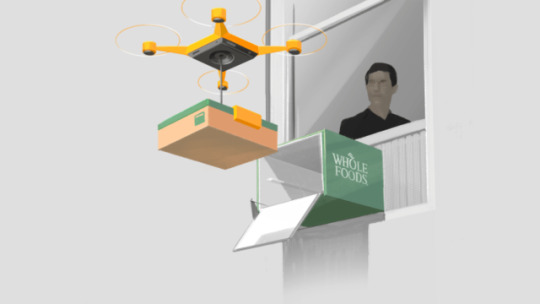
A Wild Vision Of The Future Run By Amazon And Whole Foods
CONTENT SOURCED FROM CO.DESIGN
Drones. Shared refrigerators. Hydroponic garages. And never setting foot in a grocery store again.
Since Amazon bought Whole Foods for $13.7 billion, consumers have been left wondering what that partnership will ultimately look like. Will Whole Foods stores just become another face for Amazon’s anonymous distribution centers? Will Prime memberships include access to more local produce? Or will retail, as we know it, fundamentally change, as Amazon’s hyper efficiency mixes with the Whole Foods fresh, local mentality to create something entirely new?
Austin-based design firm Argodesign is betting on the latter. As a thought experiment, the studio mocked up a provocative series of concepts suggesting what an Amazon Foods could look like, if powered by drones, Echo refrigerators, and a sharing economy model reminiscent of Airbnb or Uber.
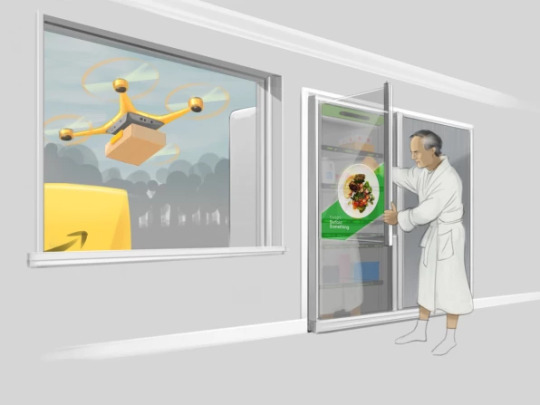
[Illustration: courtesy Argodesign]
MEET THE ECHO FRIDGE
Right now, you might order groceries through your Echo personal assistant, or reorder something through an Amazon Dash button. These items might arrive in a few hours or a few days. But what if Amazon/Whole Foods could move its stock from distribution centers and store shelves to your shelves, predictively, and adaptively?
That’s the idea of the Echo Fridge. It has an exterior-facing door. In suburban houses, it’s large, allowing a small vehicle to pull up. In urban areas, it’s a box about the size of an AC unit. Through this door, the fridge would take deliveries of food Amazon believes you will want. But you don’t pay for them unless you use them.
On the kitchen side of the Echo Fridge, you might see two doors. The door on the right would have Amazon’s suggested items, ready to eat. Move them to the left door–your personal space–and they’d be purchased automatically. Leave them, and they might be removed, delivered to a neighbor who wants that bag of oranges or bottle of ketchup.
“When we started looking at the whole problem, we started from the high level: improving distribution through robotics, and this centerpiece idea of making the refrigerator the point of sale,” says Mark Rolston, founder of Argodesign. “If you start with that point of logic, because of improved distribution, availability of robotics, and support of drones, you start to realize, the inventory in the store starts to not really matter. And the store doesn’t matter as it does today to host inventory.”
This is the fundamental shift of the concept–the store is no longer the store. Your home is now the store. And while, yes, it’s a slightly unsettling thought to not own everything in your fridge, where Argodesign takes this idea empowers the individual–as much as it enslaves them to Amazon’s will.
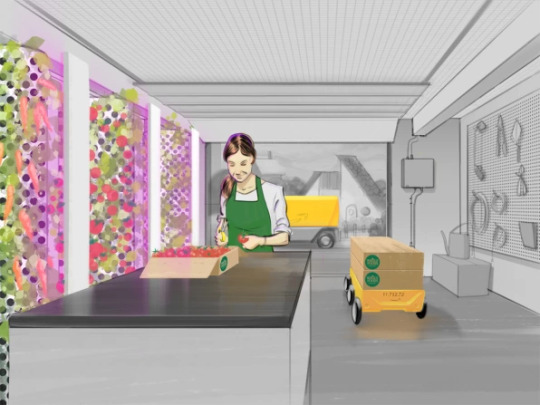
[Illustration: courtesy Argodesign]
THE GARAGE GARDEN
If self-driving cars take over, fewer people will probably own cars, and there’s a good chance that the average suburban household will suddenly have an open room in their garage. Here, Argodesign imagines what they call “Whole Foods Produce As Service.” For a monthly fee, you get a hydroponic system, with hardware owned and maintained by Amazon, and an employee comes by every few weeks to prune your garden.
You take what you like–and possibly pay a subsidized price for the fresh tomatoes and herbs. The rest is sold in a hyperlocal farmers’ market. Much like your fridge shares unopened milk, your garden would share ripe veggies that would otherwise go uneaten.
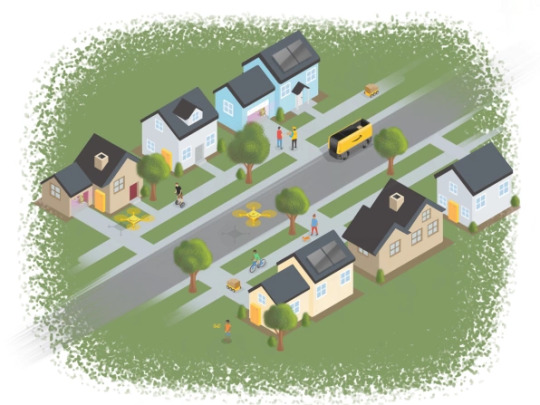
[Illustration: courtesy Argodesign]
“Everyone thinks Amazon is the big dog, and it will just gut the [Whole Food] stores,” says Jared Ficklin, creative technologist and partner at the firm. “I doubt that. I think Whole Foods will have an influence as well.” In a best-case scenario, that influence would tap Whole Foods’ ability to source regional produce, but at the extreme scale. Local fresh would no longer constitute a farm 100 miles away. Local fresh would be turnips grown by someone in your cul-de-sac.
“If Amazon is doing this successfully, it’s kind of scary. I could imagine a reader saying, ‘Holy shit, you want Amazon to be wholly in charge of what you eat?” says Rolston.
“No, we want Whole Foods to be in charge of what you eat!” says Ficklin.
“We want to plug into this system,” says Rolston. “It’s [Amazon’s] infrastructure. But it’s for us, feeding ourselves. Their infrastructure allows us to share our food in a more productive way.”

[Illustration: courtesy Argodesign]
UNLOC FOOD SCANNER
In what is by far the most science fiction-y idea in this bunch, Argodesign takes food sharing to its ultimate conclusion. With the Unloc Food Scanner, not only could you grow produce for your neighbors, you could cook meals for them, too.
Amazon would be something like Blue Apron crossed with Airbnb–for dinner, “right down to finding the person in your neighborhood [who] makes amazing Indian food to get them 20 customers,” says Ficklin.
The scanner would be loaded with a mass spectrometer, capable of looking at a dish to spot allergens and pathogens. Each package would be like a mini FDA, that could ensure a home-cooked dish from four doors down was safe for you to eat.
“We thought of this Tupperware container that scans the food and nutritional value, and it occurred to us, if you had something like that, you could usurp the packaged food industry,” says Ficklin. “A lot of work goes into food safety rather than nutrition. If you ever tried to sell something at a farmers’ market, you realize you’re up against big government. With a container like this, you could decide to sell your amazing Waldorf salad to neighbors, and they could know that there are no peanuts in it.”
It’s a wild idea, yes, but it’s also an excellent example of how a company with limitless resources, and motivation to ship things as little as possible to save money and expedite delivery times, could actually empower hyperlocal eating. (It could be a fun way to meet your neighbors, too.)
“What do people do in their lives when automation takes away so much of the manual craft we spend our time doing?” Rolston ponders aloud. “It could turn life into the Etsy of everything, the bespoking of the most ordinary aspects of living. Maybe, rather than keeping us away from each other, stronger data systems help us get closer to each other.”

[Illustration: courtesy Argodesign]
THE AMAZON BIN
For the final item in the concept brief, Amazon would leverage its network not to deliver your food but to take your trash.
Maybe you’ve tried something Amazon has sent you, and you didn’t like it at all. But all Amazon sees is that you consumed it. How does Amazon learn what you like, and what you don’t–as passively as possible?
For this, Argodesign suggests the Amazon Bin. It’s a garbage can with two holes. One says reorder. One says don’t. Anything going in is scanned, and so Amazon learns your preferences by your garbage.
But the much bigger play is what Argodesign has dubbed “waste as service.” They postulate that Amazon can create a revenue stream out of recyclables, while rewarding users for better habits. An apple thrown out whole might, at the end of the month, cost the user more than one that is eaten. But that same user might get a credit for recycling a can of consumed Diet Coke. At scale, it would be a mindless way for consumers to be greener, allowing Amazon to recycle and compost their goods. And it might lead to some earned back cash, too.
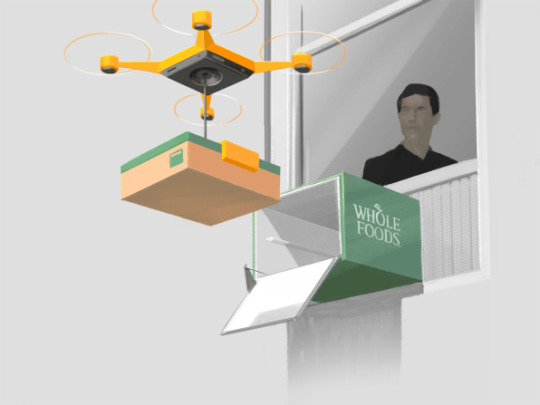
[Illustration: courtesy Argodesign]
A DISQUIETING FUTURE? MAYBE
As irresistible as it may be to open your fridge and see a gleaming produce aisle that’s been automatically, algorithmically delivered staring back at you, of course it’s all equally unsettling, too. Do I really want to buy milk that was stored in my neighbor’s fridge? Wouldn’t I be crazy to let Amazon catalog how much of that Snickers bar I actually ate? Who in their right mind would allow a big corporation to install their own garden in their precious garage?
“Isn’t Etsy proof enough?” Rolston asks. “For Airbnb, Uber, Etsy, the initial reaction was always more abstracted, divorced from the moment of value. ‘I’m not getting in some stranger’s car! I’m not buying random shit from a neighbor down the street! I’m not staying in a stranger’s house! And then, ‘okay!’–it becomes a thing.”
Ficklin chimes in. “I think the argument you’re making is very similar to the privacy argument, where people are creeped out to give privacy to get features,” he says. “But you know what consumers do every time? They give up privacy to get features! People still say, ‘This is gross and creepy!’ but they immediately do it because it’s easier and better.”
CONTENT SOURCED FROM CO.DESIGN
#amazon#wholefoods#drones#hydroponics#hydroponic farming#vertical farming#urban agriculture#urban farming#sharing economy#local food#hyperlocal#farmersmarket#futurism#tech#retail#Argodesign#Amazonbin#Co.Design
14 notes
·
View notes
Text
In episode 35 we talk with Mark Rolston who is the Founder and Chief Creative Officer at argodesign as part of a series of conversations at Interaction 20 in Milan by IXDA.
Formerly he served as Chief Creative Officer of frogdesign, founding the firm’s software business and guiding its transformation into a modern strategic design organization.
Mark shares insights from over 30 years of design experience: how he experienced the transformation of technology, society and design in the last 30 years and where he sees it going. We touch on the mixed reality and how technology and computing at large are changing human behaviours in both positive and negative ways.
We also explore invisible interfaces, how present AI is already in our today’s life and how digital design systems have changed the way software is designed. Mark also shares inspiring perspectives on the role of design and why it is a more “designable” world than ever. We also talk about where he sees design evolving and the role of user experience moving forward. Exciting insights and inspiring perspectives.
Thanks to Mark for the great time and IXDA and Interaction 20 for the support.
https://www.designdrives.org/episodes/35

1 note
·
View note
Video
youtube
Autonomous Drone Ambulance Concept by argodesign
“Want to get an ambulance through urban environments faster? Give it propellers and space for one passenger.”
Case study writeup: www.argodesign.com

#concept#drone#ambulance#autonomous#autonomous vehicles#autonomous transportation#emergency response#prototype#flying#flight#artificial intelligence#ai#argodesign
0 notes
Text
The Ambulance Drone That Could Save Your Life
The Ambulance Drone That Could Save Your Life
Video Reveals How Flying Robots May Someday Carry The Injured To Hospital
https://videopress.com/embed/LJ1fcodl?hd=0&autoPlay=0&permalink=0&loop=0
” In some rural areas, people can be left waiting hours for emergency support. But a new drone ambulance has been designed that could dramatically cut wait times and save lives.
The drone concept does not need a pilot, and is small enough…
View On WordPress
#Argodesign#Austin#Autonomous Flight#Drone Ambulance#EMT Delivery#GPS Guided Flight#Mark Rolston#Patient Evacuation#Quadcopter Ambulance#Texas
0 notes
Photo

September’s global CreativeMornings theme DEPTH will be discussed by Christine Garvey on Friday the 30th.
Join us for Cuvée Coffee & breakfast tacos.
Our musical guest with be Leti Garza.
Say thanks to our partner argodesign.
Register to get your free ticket here.
Take the conversation deeper with the hashtags #CMdepth & #CMATX
0 notes
Photo

The #zoom preamble from Friday's @cm_austin on "UNDERDOG". A manifesto read by @kjtcreative on her 6th volunteer anniversary, espresso shots by @mssierrabailey on her Doers, Shakers, Makers workshops, @ceedigs for @austindesignweek , #ASL interpreters Hannah and Gina from 3 Bridges, thanks to our sponsors @mailchimp @wordpressdotcom @argodesign and basecamp. @rabidgram on the AV, yours truly for the @gonzoviz #livedrawing and of course our hosts @antsybee @brandwriter @bthoma #cmatx #CreativeMornings #austin #atx #Texas #art #drawing #sketching #sketch #livesketching #procreate #digital #sketchnotes #remote #virtual #event #artistsoninstagram (at Austin, Texas) https://www.instagram.com/p/CDZ5_6lFB6D/?igshid=3hyolp2g9op
#zoom#asl#livedrawing#cmatx#creativemornings#austin#atx#texas#art#drawing#sketching#sketch#livesketching#procreate#digital#sketchnotes#remote#virtual#event#artistsoninstagram
1 note
·
View note
Text
People expect to spend at least 4 hours a day in the metaverse
As the concept of the metaverse has entered the mainstream, everyone from comedians to Wall Street analysts have taken to framing the much-hyped concept as a vague business meme that doesn’t stand a chance at success. Now, a survey from McKinsey refutes some of the skepticism directed at the metaverse. It found that Gen Z, millennials, and Gen X consumers expect to spend between four and five hours a day in the metaverse in the next five years. Comparatively, a recent Nielsen study found that consumers spend roughly five hours a day watching TV across various platforms.
The McKinsey study surveyed over 1,000 consumers aged 13 to 70 to hone in on the expectations and realities of the transition from laptops and smartphones to wearable devices for virtual reality (VR) and augmented reality (AR).
The race to mainstream immersive computing is still in its early stages
The most well known metaverse device is the Meta Quest 2 VR headset. It’s primarily used for gaming. That may change soon. Immersive shopping, followed by telehealth appointments, education, travel, and socializing in VR or using AR will be the most interesting metaverse activities for consumers in the next five years, according the study.
One reason the broad adoption supported by these dynamics is still a few years off is because of the limited options when it comes to easy-to-use immersive devices. There may be more choices for consumers and more competition for Meta soon. TikTok parent company Bytedance is rumored to be readying a launch of its Pico standalone VR headset in the coming months.
A Meta employee wears the company’s Project Aria augmented reality smart glasses prototype.
The best AR devices are primarily offered by Microsoft and Magic Leap for thousands of dollars. But Meta, Google, and others are far along in their development of affordable and fashionable AR smart glasses for general consumers. Apple is said to be preparing the announcement of its immersive wearable device in January 2023.
Most users will need to embrace a new computing metaphor to harness the power of the metaverse
Despite these advances, immersive interfaces are largely unfamiliar and, in some cases, difficult to use compared to an iPhone, for example. That will need to be addressed in order to move users into this next phase of computing.
“[Current AR smart glasses] give you a metaphor that looks like an Android phone on your face. So rectangles floating in space. That’s not enough for [mainstream smart glasses] adoption to happen,” Jared Ficklin, chief creative technologist at Argodesign, a former Magic Leap partner, said.
A concept illustration of future augmented reality smart glasses.
“Before Windows was developed, you had to understand directory based computing, very few people did. Once the Windows new metaphor was placed on computing, which was based on the 1960s office—putting files into folders and having a desktop—suddenly 30% of the population could understand that, and they began using computers on average, six to eight hours a day,” says Ficklin.
But how will mainstream computer users move from an office-work based metaphor on two-dimensional screens like smartphones, tablets, and PCs to a three-dimensional immersive metaphor in glasses and goggles?
“[The new metaphor will be] mapping,” Ficklin says. “We need to take the way that we, as humans, think of geography in terms of mapping and create a computer metaphor. [We will use] the language of landscape, layers, and objects.”
0 notes
Photo

Self-Driving Car Crashes Are Inevitable. Could A Flying Airbag Help? From Argodesign comes the Hero... http://ift.tt/2naLEzl
#themakersmovement#Public RSS-Feed of theMAKERSMOVEMENT. Created with the PIXELMECHANICS 'GPlusRSS-W
1 note
·
View note
Text
Elon Musk Reveals That A New Hyperloop Has Been Approved, Making NYC to DC Trip in Only 29 Minutes

Much to the relief of the tired souls who just done complaining about their hectic commute, iconic figure Elon Musk announces that the new Hyperloop will make their commute time much shorter, taking only twenty-nine minutes to travel instead of four hours from New York to Washington DC.
SpaceX and Tesla’s owner made this big statement in a series of Tweets that confirm that he has already received verbal approval for the Boring Company to build this Hyperloop linking the two cities.

And this has got everyone on the East Coast pretty excited.

Photo: argodesign
In a scenario where, right now, it takes four agonising hours to drive between New York City and Washington, DC, and a frustrating three hours to just to travel by train.
The successful completion of this cutting-edge transportation system will not only save a lot of time in people’s lives but also will mark a monumental step towards designing a technology that will have tackled traffic congestion.
Musk has ensured his followers that the Hyperloop will have multiple entries and exit points, making stops Baltimore and Philadelphia along the way.

Keep your eyes on the tech genius’s Tweets to find out more about this great initiative.
THIS IS WHAT THE HYPERLOOK MAY LOOK LIKE:















h/t: [Inhabitat & My Modern Met]
221 notes
·
View notes
Photo

Found an old @argodesign notebook. Great stuff here gents. (at San Mateo, California) https://www.instagram.com/p/B-jDEFeFfR80eBwuPHe1bEcKcY2BjUGG79owqI0/?igshid=8sbmxzcjizju
0 notes
Text
The techno-utopian eyesights of Google and Facebook are lifeless. What comes next?

Simply previously this month, while fulfilling with Our lawmakers to cover electronic personal privacy, blackout, and also transparency, Republican Politician Josh Hawley talked to Facebook's Sign Zuckerberg to unload of WhatsApp as well as Instagram. (You can possibly reckon Zuckerberg's action.) Part of Hawley's objection of Facebook was actually the fact that the firm regularly relocates personal data coming from WhatsApp and also Instagram to the core Facebook platform. This should happen as not a surprise to individuals-- never ever neglect you're the product-- yet it's simply another tip that the technology leviathans to whom our company've gifted our personal information have actually taken calculating much past what we originally desired it to become.
This is certainly not the techno-utopia I presumed our experts will create. Our experts've gone coming from imagining gigantic leaps for humanity to combating hate speech, Russian false information, and also political leaders who utilize innovation to warp public discourse with deceptions and hostility. In the very early 1990s, the techno-utopian principle developed breathlessly, assuring a new world that was cleared coming from the cruft of the worn out, old constructs that were actually unjust, top-down, and regulated by a highly effective as well as affluent best. Modern technology would certainly transform how our team corresponded, carried out company, found out, and discussed updates. It would certainly supply power to the individual, free of charge from human prejudice. Those developing the brand new technician and those captivated along with the promise really did not quit to assume regarding what would happen next. So our experts unintentionally delegated a little handful of technology providers to develop this endure brand new world: Google.com, Facebook, Twitter, and also others.
They launched completely brand-new social and interactions frameworks out of thin air without the clean understanding that the present social systems they were actually displacing took hundreds, occasionally thousands of years to put in place. Technology on its own is actually certainly not the issue. It's your business model that steers a number of the biggest systems.
The choice to spend for these services with our exclusive data is actually what produced the monster. Social networking site firms are actually cashed through advertising, and advertisers are their real clients. They possess no certain interest in our well-being, various other than the threat it gives to their business. They may not be particularly heinous, but as a system they are actually obsessed in the profiteering of our attention. Too considerably of our daily adventure is today controlled by systems that are actually extracting our information and also our opportunity to obtain our company to get factors.
The egalitarian sight of a techno-utopia lost its own way. Enormous wide range and also energy has been actually given on a couple of events presently responsible of our computer future. Our experts turned over our future to a couple of billionaire kids in Silicon Valley. Also as they make billions coming from units that are actually efficiency fools and also spreading exists that are damaging our democracy, our experts experience powerless to their prevalent existence and also influence.
The reaction is actually creating, with somebodies utilizing their platforms to overcome. As is a neo-Luddite motion, where the spontaneous response is to refute any type of location for technology. Our experts obviously need a brand-new perspective to help our team consider innovation's duty in our lives.
Back in the late '90s, Mark Weiser, the CTO of proving ground Xerox PARC, created the phrase "common processing," describing a set of guidelines that consisted of an unbelievably simple, great suggestion: "The function of a pc is actually to assist you do another thing." We must put that concept to work today with a new feeling of purpose: a movement centered around what I phone "techno-pragmatism," devoted to assisting the planet step beyond the vanity, false information, hyper-commercialization, and also distractions of today's design.
This isn't a blindly positive worldview. It acknowledges that today's dour take on modern technology is certainly not since it's naturally negative, but considering that it has actually pertained through criminals and also petty reasons. Modern technology may be a power for honest truth, awareness, openness, individuality, and also social excellent, if our company hold it to those requirements-- certainly not perfect, yet pragmatic.
The primary canons of techno-pragmatism are actually rooted in generating market value for folks as opposed to shareholders:
The purpose of technology is to improve lifestyle, to obtain from Weiser.
New technology is actually certainly not automatically a much better solution.
Social habits emerging coming from new modern technology must combine with social norms, or even typically illustrate measurable social advantages. In a similar way, brand-new technologies must be actually evaluated for social value prior to embracing.
Our team are not the product. Technology ought to provide the private and also certainly not marketers.
Technology is a magnifying glass that is going to drastically size both good and negative individual interactions as well as intent.
If these concepts come to be top-of-mind for federal government, press, individuals, and also the business they select to assist, our company can save the tech industry from itself and also initiate a new period for exactly how it suits our lives.
The social networking sites sweets and also advertising giants of the very early aughts took off in scale, yet have actually degenerated right into dumpster fires. Thus what comes next for all of them? It may not be actually merely much more customers, more advertisements, far better protocols, as well as a deeper dip our lives. They must evolve beyond flowery pep talks and also evasive testament. Our team are actually trembling almost an internet bad, through which the world would arguably be much better without them. What we, our authorities, the press, and also the firms our team employ along with can possibly do is judge our adoption of innovation via a sharper lens, one without out of breath positive outlook or the cynicism we're presently leaning into. The contrast of "relocation fast as well as damage things": An additional practical, determined, well thought-out strategy developed to suit and also create a better world.
The truth is actually that as well numerous these days's technologies are actually certainly not focused on advancing the human condition. It is actually certainly not as well late to alter program.
Sign Rolston is the main artistic policeman of Argodesign.
This content was originally published here.
0 notes